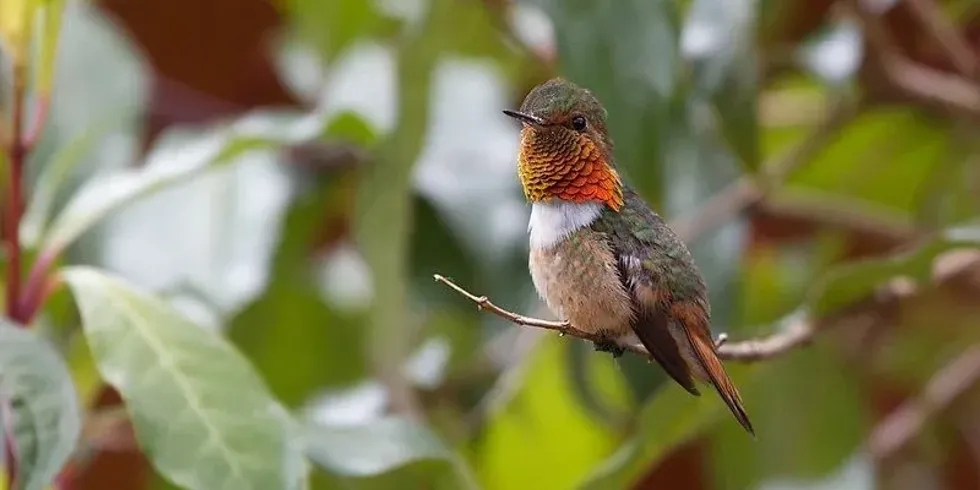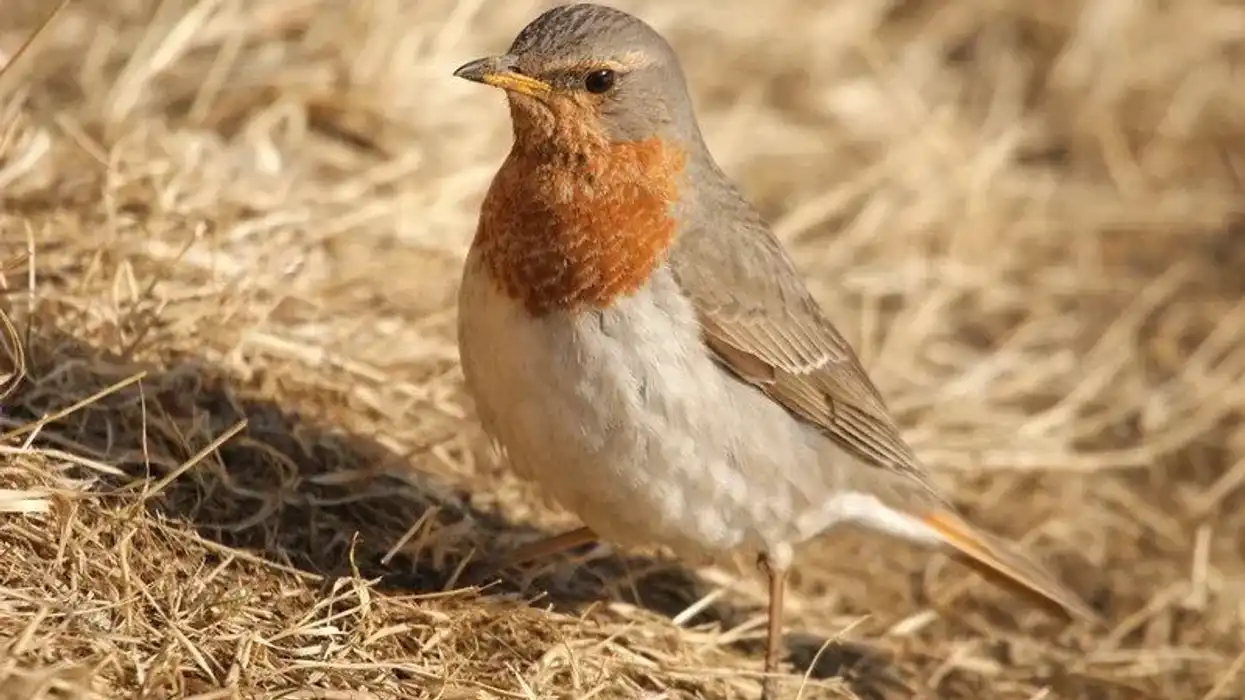The scintillant hummingbird is a type of hummingbird that belongs to the family Trochilidae, the kingdom Animalia, class Aves, order Apodiform, and genus Selasphorus. The scientific name of the scintillant hummingbird is Selasphorus scintilla.
It is the smallest known hummingbird in the western mountains of Costa Rica and Panama. Its habitats mainly include open areas, gardens with a variety of small flowers, bushy forested areas, and mountains at altitudes from 900 ft (274 m) where they built their nests in forks of branches to lay their eggs.
The male shows a range of colors and the females are a bit dull in color with rufous feathers.
The bright orange color on the neck of males distinguishes it from the females. The bills of this species are black, short, and straight by which it sucks out nectar from small flowers which is their usual diet.
Also, some insects are a source of protein to this genus. The scintillant hummingbird's feet are tiny and delicate.
The breeding season of the bird varies with the coffee plantations or variety of flowers present around the area. After copulation, the adult male leaves and is further not responsible for the parenting of the chick.
After an incubation of 19 days, the female lays two white eggs in a cup-shaped nest with scrub, soft plant fibers in small plants with a height of 39-157 in (1-4 m). The species is not on the endangered list and is considered as of Least Concern.
You can also read interesting facts about flycatchers and mountain chickadees.
Scintillant Hummingbird Interesting Facts
What type of animal is a scintillant hummingbird?
The scintillant hummingbird (Selasphorus scintilla) is a member of the Trochilidae family and is one of the smallest hummingbirds in the world.
What class of animal does a scintillant hummingbird belong to?
The scintillant hummingbird (Selasphorus scintilla) belongs to the Aves class of animals.
How many scintillant hummingbirds are there in the world?
The population size of scintillant hummingbirds is not quantified as no research sources provide the total number of the species present in the world, but they have a stable, small range.
Where does a scintillant hummingbird live?
The natural habitat of the scintillant hummingbird (Selasphorus scintilla) is America, the western mountains of Costa Rica, and Panama. It mostly prefers gardens at altitudes from 3,000–6,600 ft (900–2,000 m ), up to 8,200 ft (2,500 m) although the volcano hummingbird, a cousin of this species, is seen at greater elevations.
What is a scintillant hummingbird's habitat?
The scintillant hummingbird (Selasphorus scintilla) mostly lives in brushy forest edges, western mountains (Costa Rica), gardens at altitudes from 900 ft (274 m) and above, coffee plantations, grasslands, and tundra regions.
Who do scintillant hummingbirds live with?
They live as isolated creatures, and only during the breeding season do they mate with their partner.
How long does a scintillant hummingbird live?
The scintillant hummingbird has a life span of about three to five years.
How do they reproduce?
The male bird rests in open places and attracts females by divine displays. They are solely in charge of mating with a female.
Males display by flying in a U-shaped manner in front of females to attract them and is not responsible for nurturing the chicks. Two white eggs are laid in a batch, which the female incubates alone for 15-19 days while the male displays as a protector of his territory.
The female scintillant hummingbird is in charge of building the cup-shaped nest, which is made of woven plant fibers with green moss on the outside for disguise, in a protected site around 3-13 ft (1-4 m) high in the scrub.
The building of the nest with soft plant fibers is to provide adequate space for the chicks to grow.
The female is the sole one who watches after the chicks and feeds them disgorged food (mainly partially digested insects because nectar is the insufficient source for the growing chicks), which she forces down the chicks' necks and into their stomachs with her long bill.
What is their conservation status?
The scintillant hummingbird (Selasphorus scintilla) has a conservation classification of Least Concern. The species' population looks to be stable, indicating that this bird is not a Vulnerable species.
Scintillant Hummingbird Fun Facts
What do scintillant hummingbirds look like?.

The scintillant hummingbird is one of the smallest hummingbirds with a band of colorful features and a black, short, and straight bill. The adult male scintillant hummingbird has bronze-green upperparts and a reddish-brown, black-striped tail.
A white neckband separates the vivid red throat from the cinnamon underparts. The female is similar to the male but has a polished throat with small green patches and rufous flanks. Young birds have reddish-brown fringes on their upper part feathers, similar to the female.
How cute are they?
With a range in color and features, the scintillant hummingbird is indeed the cutest bird in the world.
How do they communicate?
In general, this hummingbird is silent but at times it makes a squeaky sound. It makes a flowing 'tsip' sound with its call, usually when sucking nectar from small flowers. The males during the breeding season usually show a display dive to attract their mate and do not use vocalizations or calls like the birds.
How big is a scintillant hummingbird?
The scintillant hummingbird has a length of about 2.6–3.1 in (6.5–8 cm) and a height of about 3 in (7 cm) and the male weighs 0.071 oz (2 g) and the female 0.081 oz (2.3 g). Being one of the smallest species among all, it is about half the length of a vesper sparrow.
How fast can a scintillant hummingbird fly?
There are no studies specifically on scintillant hummingbirds. The hummingbirds in general can fly at a maximum speed of 61 mph (98 kph).
How much does a scintillant hummingbird weigh?
The male weighs 0.071 oz (2 g) and the female 0.081 oz (2.3 g).
What are the male and female names of the species?
There are no sex-specific names for scintillant hummingbirds.
What would you call a baby scintillant hummingbird?
A baby bird is called a nestling, hatchling, or chick. The young birds are born blind and look similar to the females.
What do they eat?
The scintillant hummingbird (Selasphorus scintilla) eats both plants and animals as food. They have a very high metabolism rate and eats every 10-15 minutes a day.
It usually feeds on nectar taken from a range of bright-colored, scented small flowers, the source including salvia and insect-pollinated species; also on tiny insects like lace bugs, kudzu bugs, flatworms, and tangle web spiders, which are a major source of protein in their diet.
The species uses its long tongue to suck out the nectar while hanging on the flower with its tails stretched upwards.
They also sip in water from small rivers, water fountains, lakes. During the breeding season, males perches in open spaces with salvia.
Are they dangerous?
No, these species are not considered dangerous or do not possess serious threats to human life. Whenever the bird feels threatened, it has a tendency to fly off.
Would they make a good pet?
No, the birds under this species never make a good pet as they are free wild birds belonging to the open places and brushy forest edges. Sometimes in captivity, they lose their free state and do not survive for long.
Did you know...
They are one of the smallest birds in the world.
How did the scintillant hummingbirds get their name?
The birds get their name from the humming sound with the flapping of wings at high frequencies and sometimes also due to its sparkling bright color of this birds it is called as 'scintillant'.
What is the wingspan of the scintillant hummingbird?
The scintillant hummingbird (Selasphorus scintilla) of Costa Rica has a wingspan of 4.25 in (10.8 cm).
Here at Kidadl, we have carefully created lots of interesting family-friendly animal facts for everyone to discover! Learn more about some other birds from our Anna's hummingbird facts and vesper sparrow facts pages.
You can even occupy yourself at home by coloring in one of our free printable scintillant hummingbird coloring pages.
Main image by Matt MacGillivray.
Second image by Charlie Jackson.










